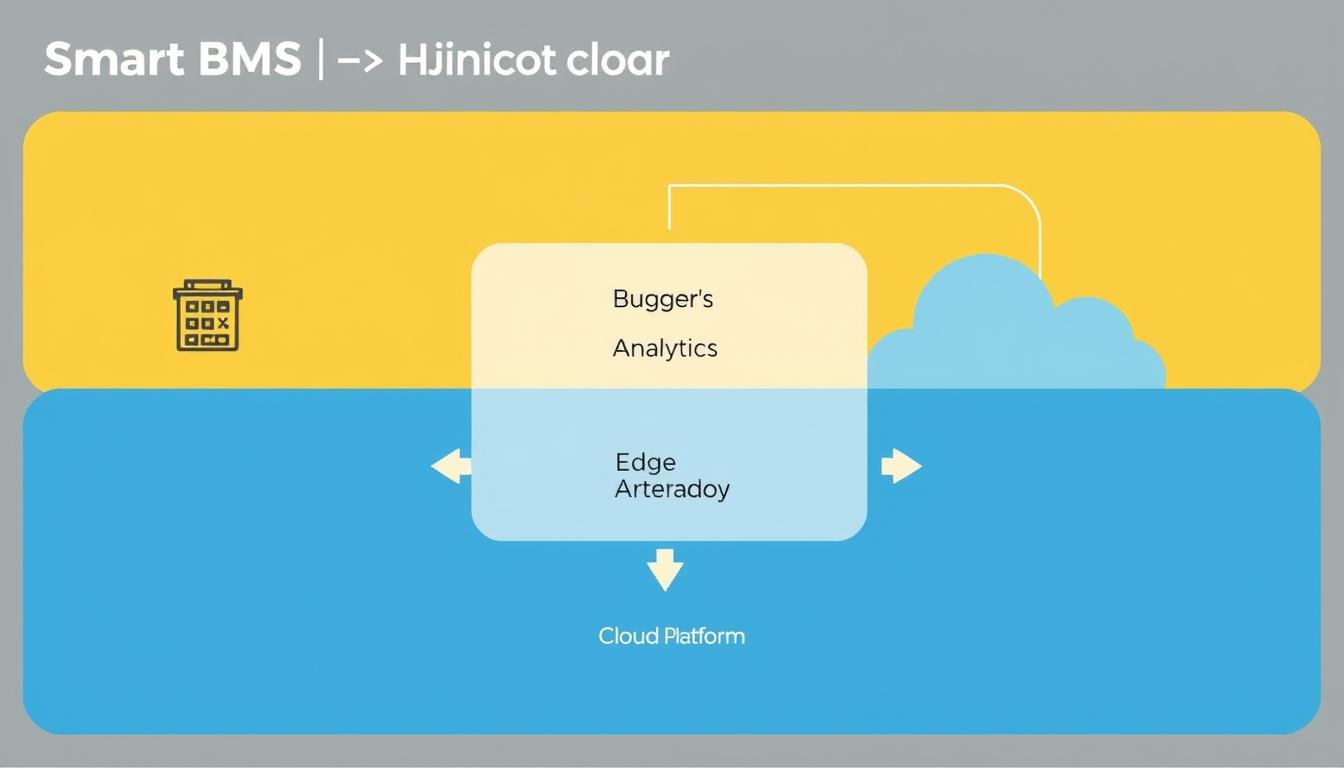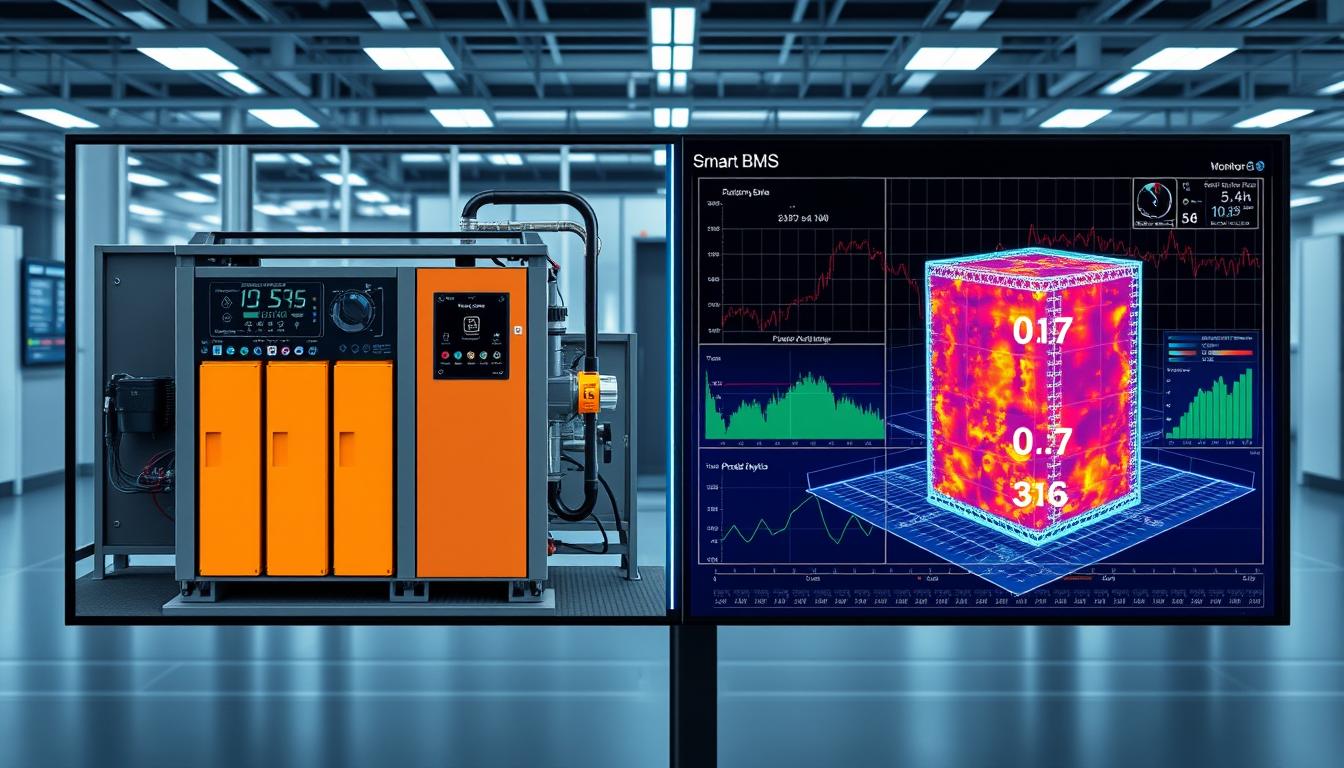
The convergence of Smart Battery Management Systems (BMS) and Internet of Things (IoT) technology is revolutionizing how we monitor, manage, and optimize energy storage systems. For Original Equipment Manufacturers (OEMs), mastering this integration unlocks new capabilities in predictive maintenance, energy optimization, and remote management. This comprehensive guide explores the technical considerations, implementation strategies, and best practices for seamlessly connecting Smart BMS with IoT ecosystems.

Figure 1: Smart BMS IoT integration architecture showing data flow between components
A Smart Battery Management System (BMS) serves as the critical intelligence layer between energy storage systems and the broader IoT ecosystem. Unlike traditional BMS solutions that simply monitor and protect batteries, Smart BMS leverages advanced connectivity to enable real-time data exchange with cloud platforms, edge devices, and enterprise systems.
By connecting Smart BMS to IoT platforms, OEMs enable a continuous feedback loop that enhances system performance, extends battery life, and provides valuable insights for both operators and end-users. This connectivity transforms batteries from passive components into intelligent assets within the broader energy ecosystem.

Figure 2: Technical evaluation of protocol compatibility for Smart BMS IoT integration
Successfully integrating Smart BMS with IoT systems requires careful consideration of several technical factors. OEMs must navigate protocol compatibility, data security, and processing architecture to ensure reliable and efficient operation.
| Protocol | Advantages | Limitations | Best For |
| MQTT | Lightweight, low bandwidth, publish/subscribe model | Limited message size, basic QoS | Resource-constrained devices, telemetry data |
| Modbus TCP/IP | Industry standard, simple implementation | Limited security features, polling overhead | Industrial applications, legacy system integration |
| OPC UA | Rich metadata, strong security, discovery services | Higher resource requirements, complexity | Enterprise integration, complex systems |
| REST API | Widely supported, stateless, scalable | Higher latency, not ideal for real-time | Cloud integration, web applications |
Implementing robust security measures is critical for Smart BMS IoT integration. Battery data can reveal sensitive operational patterns and potentially expose systems to unauthorized access or control.

Figure 3: Hybrid edge-cloud architecture for Smart BMS IoT integration
Determining where to process BMS data is a critical architectural decision that impacts system responsiveness, reliability, and scalability. A hybrid approach often provides the best balance:

Figure 4: Implementation workflow for Smart BMS IoT integration
Successfully connecting Smart BMS to IoT platforms requires a methodical approach that addresses both hardware and software considerations. The following step-by-step strategy provides a framework for OEMs to implement robust and scalable integrations.
Begin by clearly identifying the specific data points, control capabilities, and performance metrics needed from your BMS. Document the required sampling rates, accuracy levels, and latency tolerances for each parameter.
Choose communication modules that support your required protocols while considering power consumption, range, and reliability. For battery-powered systems, low-power options like BLE, LoRaWAN, or NB-IoT may be preferable to Wi-Fi or cellular connections.
Develop firmware that performs initial data validation, filtering, and compression at the BMS level. This reduces bandwidth requirements and ensures only relevant data is transmitted to the IoT platform.
Implement encryption, authentication, and secure key management for all data exchanges between the BMS and IoT platforms. Consider using hardware security modules (HSMs) for critical applications.
Create a standardized API that abstracts the underlying BMS complexity and provides consistent data access patterns for IoT platforms. Document this API thoroughly for third-party integrations.
Design a tiered storage approach that keeps recent, high-resolution data accessible while archiving historical data for long-term analysis. Consider time-series databases for efficient storage of sensor data.
Develop dashboards and control interfaces that present BMS data in an intuitive format. Focus on actionable insights rather than overwhelming users with raw data.
Implement comprehensive testing that validates data accuracy, communication reliability, and system behavior under various conditions including connectivity loss and power fluctuations.
Our team of BMS integration specialists can help you develop a customized approach for your specific application requirements.
Schedule a Strategy Session
Figure 5: Smart BMS IoT dashboard showing predictive maintenance and optimization capabilities

Figure 6: Implementing redundancy measures to overcome connectivity challenges

Figure 7: Industrial IoT application with Smart BMS integration for energy management
Smart BMS IoT integration is delivering tangible benefits across multiple industries. These real-world applications demonstrate how the technology is solving specific challenges and creating new opportunities for system optimization.
Manufacturing facilities are leveraging Smart BMS IoT integration to optimize energy usage during peak demand periods. By connecting battery storage systems to production scheduling software, factories can shift energy-intensive processes to times when renewable energy is abundant or grid prices are lower.
Key Benefits: 30% reduction in energy costs, improved grid stability, and enhanced sustainability metrics.
Solar and wind installations with battery storage are using Smart BMS IoT integration to maximize energy capture and optimize discharge timing. Cloud-based analytics platforms predict generation patterns and grid demand to determine optimal charging/discharging schedules.
Key Benefits: 25% increase in renewable energy utilization and improved grid integration capabilities.
Fleet operators are implementing Smart BMS IoT integration to monitor battery health across vehicles and optimize charging infrastructure. Predictive analytics help schedule maintenance based on actual battery condition rather than fixed intervals.
Key Benefits: Extended battery life, reduced downtime, and optimized charging infrastructure utilization.

Figure 8: Renewable energy storage facility utilizing Smart BMS IoT integration
Telecommunications providers are using Smart BMS IoT integration to monitor and manage backup power systems across distributed cell sites. Remote monitoring reduces site visits while predictive maintenance ensures backup systems are always ready when needed.
Key Benefits: 40% reduction in maintenance costs and improved network reliability during power outages.
Critical infrastructure operators are implementing Smart BMS IoT integration for UPS and backup power systems. Real-time monitoring ensures backup systems are always ready while predictive maintenance prevents unexpected failures.
Key Benefits: Enhanced reliability, optimized battery replacement timing, and reduced operational expenses.
Commercial buildings with energy storage systems are using Smart BMS IoT integration to participate in demand response programs and optimize energy usage. Integration with building management systems enables holistic energy optimization.
Key Benefits: Reduced energy costs, new revenue streams from grid services, and enhanced sustainability metrics.

Figure 9: Development team implementing API standardization for Smart BMS IoT integration
Successful Smart BMS IoT integration requires attention to several key implementation areas. These best practices will help OEMs create robust, maintainable, and future-proof systems.
Implementing standardized APIs is critical for ensuring interoperability with diverse IoT platforms and simplifying future integrations. Consider adopting industry standards like Modbus TCP, Sunspec, or OpenADR where applicable.

Figure 10: Hybrid cloud architecture for Smart BMS IoT integration
A well-designed hybrid cloud architecture balances the benefits of local processing with cloud capabilities:

Figure 11: AI-driven Smart BMS analyzing battery performance patterns
The integration of Smart BMS with IoT systems continues to evolve rapidly. Several emerging trends will shape the future landscape of this technology:
Artificial intelligence and machine learning algorithms are increasingly being applied to battery management, enabling:

Figure 12: 5G connectivity enabling advanced Smart BMS IoT integration
The rollout of 5G networks will transform Smart BMS IoT integration through:
Digital twins—virtual replicas of physical battery systems—are emerging as powerful tools for:

Figure 13: Digital twin technology enabling advanced simulation and optimization
The integration of Smart BMS with IoT systems represents a significant opportunity for OEMs to enhance the value, performance, and capabilities of their energy storage solutions. By following the technical considerations, implementation strategies, and best practices outlined in this guide, manufacturers can create robust integrations that deliver tangible benefits across various applications.
As technology continues to evolve, the convergence of AI, 5G, and digital twin capabilities will further expand the possibilities for Smart BMS IoT integration. OEMs that establish strong foundations today will be well-positioned to leverage these emerging technologies and maintain competitive advantage in the rapidly evolving energy storage landscape.
Our team of specialists can evaluate your current BMS architecture and provide a detailed compatibility assessment for IoT integration. Discover potential optimization opportunities and implementation strategies tailored to your specific requirements.
Request a Compatibility Audit